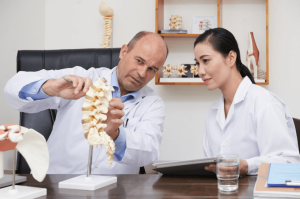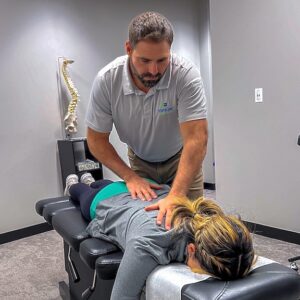When people think about back pain, they often picture someone lifting something heavy or dealing with the effects of aging. While injuries and wear and tear certainly play a part, they don’t always explain why so many individuals deal with chronic back pain, low back pain, or even discomfort that travels up toward the neck and shoulders.
At Evolve Chiropractic, we frequently hear patients say they’ve “tried everything” but still haven’t found lasting relief. That’s because the surprising causes of back pain are often missed in traditional evaluations. Addressing what lies beneath the surface – habitual movement patterns, daily stress, or even the food on your plate – can be a game-changer for your recovery.
Let’s explore the often-overlooked contributors to spinal discomfort and how you can start moving toward healing.
Unexpected Causes of Back Pain
Pain doesn’t always follow obvious rules. While some people can pinpoint a fall, a strain, or an accident, others develop persistent symptoms for no clear reason. These lesser-known triggers often hide in plain sight, subtly affecting posture, joint alignment, and muscle behavior until chronic low back pain or tension builds to a breaking point.
In the sections below, we’ll explore five surprising causes that may be contributing to your discomfort – and what you can do about them.
1. Sedentary Lifestyle & Poor Desk Posture
If you work at a desk or spend a good portion of your day seated, your spine might be absorbing more stress than you realize. Sitting for long periods – especially with poor posture – places ongoing strain on your lumbar curve. Unsupported backs, improperly placed monitors, and non-ergonomic chairs are common culprits behind nagging lower back pain.
Making small ergonomic adjustments – like aligning your monitor to eye level, adjusting your chair height, and using a lumbar roll – can make a measurable difference. Incorporate standing breaks every 30–60 minutes, stretch your hip flexors, and alternate between sitting and standing when possible. These micro-shifts can help prevent muscle tension and restore circulation to the lower back.
2. Stress, Tension & Emotional Holding Patterns
Stress isn’t just mental – it lives in the body. Emotional tension can manifest as tight shoulders, clenched jaws, or braced abdominal muscles. These patterns can lead to muscle strain, particularly in the back, shoulders, and hips.
The shoulder blade area is especially prone to tension buildup. The brain and spine are in constant communication, and when stress hits, the body often goes into protective mode. This “guarding” response leads to stiffness, shallow breathing, and even shoulder pain.
Techniques like diaphragmatic breathing, guided meditation, and chiropractic soft tissue work can help release this tension. Addressing the stress–body connection often leads to meaningful change in patients with chronic pain.
3. Nutritional Deficiencies & Inflammation
What you eat directly impacts how you feel. Diets high in sugar, processed foods, and poor-quality fats promote systemic inflammation, which can aggravate tissues surrounding the spine and joints. On the flip side, an anti-inflammatory diet can promote healing and provide natural pain relief.
Nutrients like omega-3 fatty acids, turmeric, magnesium, and vitamin D play key roles in reducing inflammation and supporting muscle recovery. Don’t underestimate the role hydration plays, either – intervertebral discs require water to stay pliable and absorb shock effectively.
If you’ve been treating back discomfort without addressing your nutrition, this may be a surprising cause of back pain you haven’t considered.
4. Footwear, Gait & Biomechanics
Your feet are the foundation for your body. Ill-fitting shoes, worn-out soles, or walking patterns like overpronation affect the alignment of your knees, hips, and spine. Over time, this misalignment creates imbalances that may show up as low back pain, hip tightness, or even pressure in the neck and upper back.
High heels, while stylish, shift the pelvis forward and compress the lumbar region. Likewise, old sneakers or unsupportive flats can lead to uneven weight distribution and chronic tension.
Custom orthotics, a gait assessment, and switching to more supportive footwear can help realign your body and relieve structural stress.
5. Lack of Core Strength & Mobility
One of the most common contributors to chronic back pain is weak or inactive core muscles. The core is more than just abdominals – it includes the pelvic floor, diaphragm, glutes, and small stabilizing muscles like the multifidus and transverse abdominis.
Without a strong core, the spine lacks support and becomes more susceptible to injury, strain, and fatigue. Basic exercises like bird dogs, side planks, and hip bridges can improve spinal stability and reduce your risk of recurring discomfort.
Mobility also matters. Stiff hips, limited thoracic rotation, and tight hamstrings can all lead to compensatory patterns and eventually trigger pain in the lower back.
Sleeping Postures & Mattress Issues
Your sleep environment plays an important role in spinal recovery. Sleeping on a worn-out mattress, in awkward positions, or without proper pillow support can strain your back through the night and lead to morning stiffness.
Avoid sleeping on your stomach, which can force your head and spine into unnatural positions. Instead, aim for side sleeping with a pillow between your knees or back sleeping with support under the knees to maintain spinal neutrality.
If your mattress is sagging, too firm, or too soft, it might be time to upgrade. Most sleep experts recommend replacing mattresses every 7–10 years to maintain optimal support for the spine.
Self-Care Tips & Daily Routines
Small shifts throughout the day can prevent discomfort from building into chronic low back pain. You can set reminders to take standing or stretching breaks during long meetings. Keep a water bottle nearby and prioritize hydration for disc and tissue health.
Try integrating desk mobility routines – like seated spinal twists or wrist rolls – and use the evening hours to release accumulated tension with gentle yoga or foam rolling. Even your snacks make a difference: nuts, berries, and leafy greens are great anti-inflammatory choices.
Swap out unsupportive shoes for something better suited to your gait, and pay attention to how your body feels throughout the day. Awareness is the first step toward prevention.
Can Chiropractic Care Relieve Back Pain?
Absolutely. Our goal is to help you move beyond just pain management or symptom relief and toward long-term resilience. Many of the surprising causes we’ve covered – postural stress, nutritional deficiencies, emotional tension – respond well to integrated care strategies.
Through chiropractic treatment, we use targeted adjustments to restore motion and alignment, helping the nervous system communicate more effectively. Soft tissue techniques and corrective exercises address muscular imbalances, while our ergonomic assessments identify daily habits that may be contributing to discomfort.
Patients with spinal stenosis, disc issues, or lingering neck pain may benefit from comprehensive evaluations that include postural screening, movement analysis, and functional assessments. In some cases, we collaborate with other providers – such as a licensed physical therapist or physical therapy professional – to support recovery from joint replacement, injury, or spine surgery.
We don’t just treat what hurts – we look at the full picture, including how your body moves, how you manage stress, and how your environment may be contributing to your pain. Every care plan is customized to your needs, preferences, and goals, whether you’re seeking relief from a symptom or aiming to prevent it altogether.
We also offer ongoing wellness tools like posture coaching, community workshops, and monthly tune-ups to help you stay ahead of future flare-ups.
Book Your Appointment Today
If you’ve been living with back discomfort and haven’t found the cause – or the solution – it’s time for a fresh perspective. At Evolve Chiropractic, we’ll help you explore what’s really behind your symptoms and work with you to create a sustainable path forward.
Book a complimentary consultation or posture screen today. Let’s find what’s holding you back – and start moving forward.





